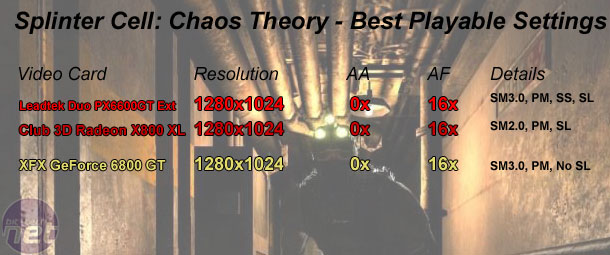Splinter Cell: Chaos Theory
Publisher: UbisoftWe used the full version of Splinter Cell: Chaos Theory patched to version 1.04. It features a new game engine that has been created around a heavily modified Unreal Engine 2 - the game used to only have two shader profiles: Shader Model 1.1 and Shader Model 3.0. All of ATI's current video cards default to Shader Model 1.1, and only the GeForce 6 series is capable of using the Shader Model 3.0 path.
However, the introduction of patch 1.04 bought a Shader Model 2.0 profile for ATI's current generation video cards. You can read more about the Shader Model 2.0 path here.
We configured both Anti-Aliasing and Anisotropic Filtering from within the game, and thus the driver control panel was left set to "Application Controlled".
Below is a table of the best-playable settings that we found best for each video card configuration. In this title, we found that 25 to 30 frames per second minimum and a target of 50 frames per second (or higher) for the average frame rate delivered a smooth and fluid gaming experience across the rest of the game.

The Club 3D Radeon X800 XL 256MB was best playable using the Shader Model 2.0 path with parallax mapping and specular lighting enabled while the XFX GeForce 6800 GT had performance issues when utilising specular lighting in our manual run through.
It's worth noting that the minimum frame rate on the Radeon X800 XL was much higher than the two NVIDIA video cards. But in contrast, the average frame rate delivered by the Radeon X800 XL was in the mid-to-low 40's rather than high 40's or low 50's on the two NVIDIA cards.

MSI MPG Velox 100R Chassis Review
October 14 2021 | 15:04








Want to comment? Please log in.